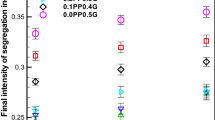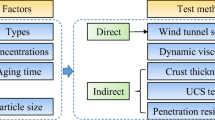Abstract
Material mixing in a rotating drum is a complex movement process, and the material mixing uniformity impacts product quality. The mixing of sand and gravel in the rotating drum was simulated by the discrete element method to study the quantitative relationship between the mixing uniformity and its influencing factors and analyze the mixing performance. The quantitative relationships between mixing uniformity and rotation speed of the rotating drum, material filling rate, and distance of rods inside the rotating drum were established based on the response surface method. Results indicate that the rotation speed of the rotating drum has the most significant influence on the mixing uniformity, followed by the distance of rods inside the rotating drum, and the material filling rate has a minor influence on the mixing uniformity. The interaction between the three factors significantly affects the mixing uniformity. The areas where the particles move in the rotating drum are divided into active and inactive areas. Rods inside the rotating drum can accelerate the movement of the particles in the inactive area, relieve particle segregation and promote particle mixing.


















Similar content being viewed by others
Data availability
Data will be made available on request.
References
Kumar S, Khatoon S, Yogi J, Verma SK, Anand A (2022) Experimental investigation of segregation in a rotating drum with non-spherical particles. Powder Technol. https://doi.org/10.1016/j.powtec.2022.117918
Adepu M, Chen S, Jiao Y, Gel A, Emady H (2020) Wall to particle bed contact conduction heat transfer in a rotary drum using DEM. Comput Particle Mech 8(3):589–599. https://doi.org/10.1007/s40571-020-00356-z
Sinnott MD, Cleary PW (2015) The effect of particle shape on mixing in a high shear mixer. Comput Particle Mech 3(4):477–504. https://doi.org/10.1007/s40571-015-0065-4
Miao Q, Huang P, Ding Y, Guo J, Jia M (2022) Particle mixing and segregation behaviors in the rotating drums with adjacent axial segmentations in different speed directions. Powder Technol. https://doi.org/10.1016/j.powtec.2022.117534
Xu G, Zhang Y, Yang X, Chen G, Jin B (2023) Effect of drum structure on particle mixing behavior based on DEM method. Particuology 74:74–91. https://doi.org/10.1016/j.partic.2022.05.008
Ardalani E, Yohannes B, Borghard WG, Glasser BJ, Cuitiño AM (2022) DEM analysis of the thermal treatment of granular materials in a rotary drum equipped with baffles. Chem Eng Sci. https://doi.org/10.1016/j.ces.2022.117476
Beaulieu C, Vidal D, Niyonkuru C, Wachs A, Chaouki J, Bertrand F (2021) Effect of particle angularity on flow regime transitions and segregation of bidisperse blends in a rotating drum. Comput Particle Mech 9(3):443–463. https://doi.org/10.1007/s40571-021-00421-1
Jain A, Evrard F, van Wachem B (2023) The effect of side walls on particles mixing in rotating drums. Particuology 72:112–121. https://doi.org/10.1016/j.partic.2022.02.011
Bao Y, Li T, Wang D, Cai Z, Gao Z (2020) Discrete element method study of effects of the impeller configuration and operating conditions on particle mixing in a cylindrical mixer. Particuology 49:146–158. https://doi.org/10.1016/j.partic.2019.02.002
Cundall PA, Strack ODL (1979) A discrete numerical model for granular assemblies. Géotechnique. https://doi.org/10.1680/geot.1979.29.1.47
Xiao X, Li B, Chen M, Peng J, Peng R (2023) Research on the effect of the cone-in-cone insert on the discharge behaviour of conical silo. Powder Technol. https://doi.org/10.1016/j.powtec.2023.118336
Xiao X, Jin Y, Tan Y, Jiang S, Chen R, Peng R (2022) Modeling and numerical research on powder paving process of nylon powder in selective laser sintering. Comput Particle Mech 10(3):415–425. https://doi.org/10.1007/s40571-022-00505-6
Gao W, Feng YT (2019) A coupled 3D discrete elements/isogeometric method for particle/structure interaction problems. Comput Particle Mech 7(5):869–880. https://doi.org/10.1007/s40571-019-00267-8
Brandao RJ, Lima RM, Santos RL, Duarte CR, Barrozo MAS (2020) Experimental study and DEM analysis of granular segregation in a rotating drum. Powder Technol 364:1–12. https://doi.org/10.1016/j.powtec.2020.01.036
Ma H, Zhao Y (2017) Modelling of the flow of ellipsoidal particles in a horizontal rotating drum based on DEM simulation. Chem Eng Sci 172:636–651. https://doi.org/10.1016/j.ces.2017.07.017
Yang S, Sun Y, Zhang L, Chew JW (2017) Segregation dynamics of a binary-size mixture in a three-dimensional rotating drum. Chem Eng Sci 172:652–666. https://doi.org/10.1016/j.ces.2017.07.019
Léonard G, Bertrand F, Chaouki J, Gosselin PM (2008) An experimental investigation of effusivity as an indicator of powder blend uniformity. Powder Technol 181(2):149–159. https://doi.org/10.1016/j.powtec.2006.12.007
Xu Y, Xu C, Zhou Z, Du J, Hu D (2010) 2D DEM simulation of particle mixing in rotating drum: a parametric study. Particuology 8(2):141–149. https://doi.org/10.1016/j.partic.2009.10.003
Bhalode P, Ierapetritou M (2020) A review of existing mixing indices in solid-based continuous blending operations. Powder Technol 373:195–209. https://doi.org/10.1016/j.powtec.2020.06.043
Cho M, Dutta P, Shim J (2017) A non-sampling mixing index for multicomponent mixtures. Powder Technol 319:434–444. https://doi.org/10.1016/j.powtec.2017.07.011
Liu X, Zhang C, Zhan J (2015) Quantitative comparison of image analysis methods for particle mixing in rotary drums. Powder Technol 282:32–36. https://doi.org/10.1016/j.powtec.2014.08.076
Jiang S, Ye Y, He M, Duan C, Liu S, Liu J, Xiao X, Zhang H, Tan Y (2019) Mixing uniformity of irregular sand and gravel materials in a rotating drum with determination of contact model parameters. Powder Technol. https://doi.org/10.1016/j.powtec.2019.06.005
He SY, Gan JQ, Pinson D, Yu AB, Zhou ZY (2021) Particle shape-induced axial segregation of binary mixtures of spheres and ellipsoids in a rotating drum. Chem Eng Sci. https://doi.org/10.1016/j.ces.2021.116491
Finnie GJ, Kruyt NP, Ye M, Zeilstra C, Kuipers JAM (2004) Longitudinal and transverse mixing in rotary kilns: A discrete element method approach. Chem Eng Sci. https://doi.org/10.1016/j.ces.2004.12.048
Puyvelde DRV, Young BR, Wilson MA, Schmidt SJ (1999) Experimental determination of transverse mixing kinetics in a rolling drum by image analysis. Powder Technol. https://doi.org/10.1016/S0032-5910(99)00074-1
Chen H, Xiao YG, Liu YL, Shi YS (2017) Effect of Young’s modulus on DEM results regarding transverse mixing of particles within a rotating drum. Powder Technol 318:507–517. https://doi.org/10.1016/j.powtec.2017.05.047
Xiao X, Tan Y, Zhang H, Deng R, Jiang S (2017) Experimental and DEM studies on the particle mixing performance in rotating drums: effect of area ratio. Powder Technol 314:182–194. https://doi.org/10.1016/j.powtec.2017.01.044
Maione R, Kiesgen De Richter S, Mauviel G, Wild G (2015) DEM investigation of granular flow and binary mixture segregation in a rotating tumbler: influence of particle shape and internal baffles. Powder Technol 286:732–739. https://doi.org/10.1016/j.powtec.2015.09.011
Dan L, Xin X, Juhui C, Kai Y, Xianli L, Liu Y (2021) Numerical study on the effect of drum on the flow behavior of binary-size particles in rotating drums. Powder Technol. https://doi.org/10.1016/j.powtec.2021.03.013
Lin J, Bao M, Zhang F, Yang J, Li H (2022) Mixing simulation of cohesive particles in a soil mixer. Powder Technol. https://doi.org/10.1016/j.powtec.2022.117218
Govender N, Kobyłka R, Khinast J (2023) The influence of cohesion on polyhedral shapes during mixing in a drum. Chem Eng Sci. https://doi.org/10.1016/j.ces.2023.118499
Liu PY, Yang RY, Yu AB (2013) DEM study of the transverse mixing of wet particles in rotating drums. Chem Eng Sci 86:99–107. https://doi.org/10.1016/j.ces.2012.06.015
Xiao X, Li Y, Peng R, Gao J, Hu C (2023) Parameter calibration and mixing uniformity of irregular gravel materials in a rotating drum. Powder Technol. https://doi.org/10.1016/j.powtec.2022.118074
Barrios GKP, de Carvalho RM, Kwade A, Tavares LM (2013) Contact parameter estimation for DEM simulation of iron ore pellet handling. Powder Technol 248:84–93. https://doi.org/10.1016/j.powtec.2013.01.063
Lima RM, Brandao RJ, Santos RL, Duarte CR, Barrozo MAS (2021) Analysis of methodologies for determination of DEM input parameters. Braz J Chem Eng 38(2):287–296. https://doi.org/10.1007/s43153-021-00107-4
Jadidi B, Ebrahimi M, Ein-Mozaffari F, Lohi A (2023) Investigation of impacts of particle shape on mixing in a twin paddle blender using GPU-based DEM and experiments. Powder Technol. https://doi.org/10.1016/j.powtec.2023.118259
Deeb R, Kulasegaram S, Karihaloo BL (2014) 3D modelling of the flow of self-compacting concrete with or without steel fibres: part II: L-box test and the assessment of fibre reorientation during the flow. Comput Particle Mech 1(4):391–408. https://doi.org/10.1007/s40571-014-0003-x
Zhang Q, Feng X, Chen X, Lu K (2020) Mix design for recycled aggregate pervious concrete based on response surface methodology. Constr Build Mater. https://doi.org/10.1016/j.conbuildmat.2020.119776
Ferreira SLC, Bruns RE, Ferreira HS, Matos GD, David JM, Brandão GC, da Silva EGP, Portugal LA, dos Reis PS, Souza AS, dos Santos WNL (2007) Box–Behnken design: an alternative for the optimization of analytical methods. Anal Chim Acta 597(2):179–186. https://doi.org/10.1016/j.aca.2007.07.011
Ding YL, Seville JPK, Forster R, Parker DJ (2001) Solids motion in rolling mode rotating drums operated at low to medium rotational speeds. Chem Eng Sci 56(5):1769–1780. https://doi.org/10.1016/S0009-2509(00)00468-1
Zuo Z, Wang J, Wu X, Gong S, Zhang J, Lu X (2022) Segregation dynamics of the binary-size granular system in a split rotary drum. Powder Technol. https://doi.org/10.1016/j.powtec.2022.117480
Gao W, Liu L, Liao Z, Chen S, Zang M, Tan Y (2019) Discrete element analysis of the particle mixing performance in a ribbon mixer with a double U-shaped vessel. Granul Matter. https://doi.org/10.1007/s10035-018-0864-4
Dubé O, Alizadeh E, Chaouki J, Bertrand F (2013) Dynamics of non-spherical particles in a rotating drum. Chem Eng Sci 101:486–502. https://doi.org/10.1016/j.ces.2013.07.011
Acknowledgements
This study was co-supported by the National Natural Science Foundation of China (Nos. 51975504, 52375466), the Provincial Natural Science Foundation of Hunan for Distinguished Young Scholars (No. 2022JJ10045), the Guangdong Basic and Applied Basic Research Foundation (No. 2022A1515110862), the Jiangsu Key Laboratory of Precision and Micro-Manufacturing Technology (No. JSKL2223K06), the Natural Science Foundation of Hunan Province (Nos. 2021JJ20009 and 2022JJ40442), and Excellent Youth Project of Education Department of Hunan Province (No. 22B0109).
Author information
Authors and Affiliations
Contributions
XX contributed to methodology, conceptualization, software, investigation, supervision, writing—review and editing, and formal analysis. JZ contributed to investigation, validation, data curation, writing—original draft, and writing—review and editing. SJ contributed to conceptualization, software, methodology, and formal analysis. RP contributed to conceptualization, supervision, and writing—review and editing. GC contributed to supervision, methodology, and formal analysis. RC contributed to conceptualization, methodology, and supervision. YL contributed to methodology, software, and supervision. LS contributed to supervision and methodology.
Corresponding author
Ethics declarations
Conflict of interest
The authors declare that they have no known competing financial interests or personal relationships that could have appeared to influence the work reported in this paper.
Additional information
Publisher's Note
Springer Nature remains neutral with regard to jurisdictional claims in published maps and institutional affiliations.
Rights and permissions
Springer Nature or its licensor (e.g. a society or other partner) holds exclusive rights to this article under a publishing agreement with the author(s) or other rightsholder(s); author self-archiving of the accepted manuscript version of this article is solely governed by the terms of such publishing agreement and applicable law.
About this article
Cite this article
Xiao, X., Zhan, J., Jiang, S. et al. The analysis of mixing performance of sand and gravel in a rotating drum by DEM. Comp. Part. Mech. (2023). https://doi.org/10.1007/s40571-023-00693-9
Received:
Revised:
Accepted:
Published:
DOI: https://doi.org/10.1007/s40571-023-00693-9




